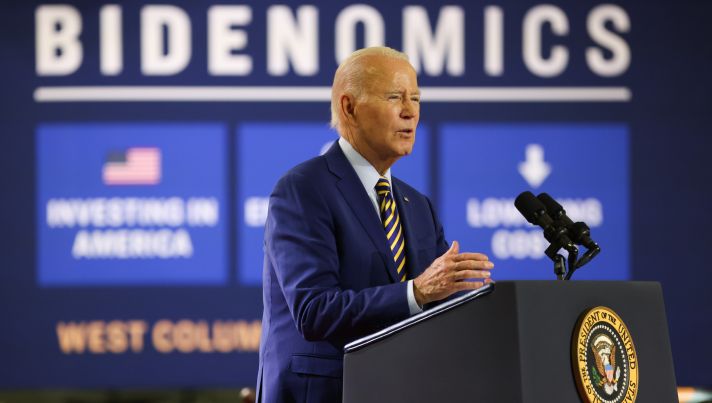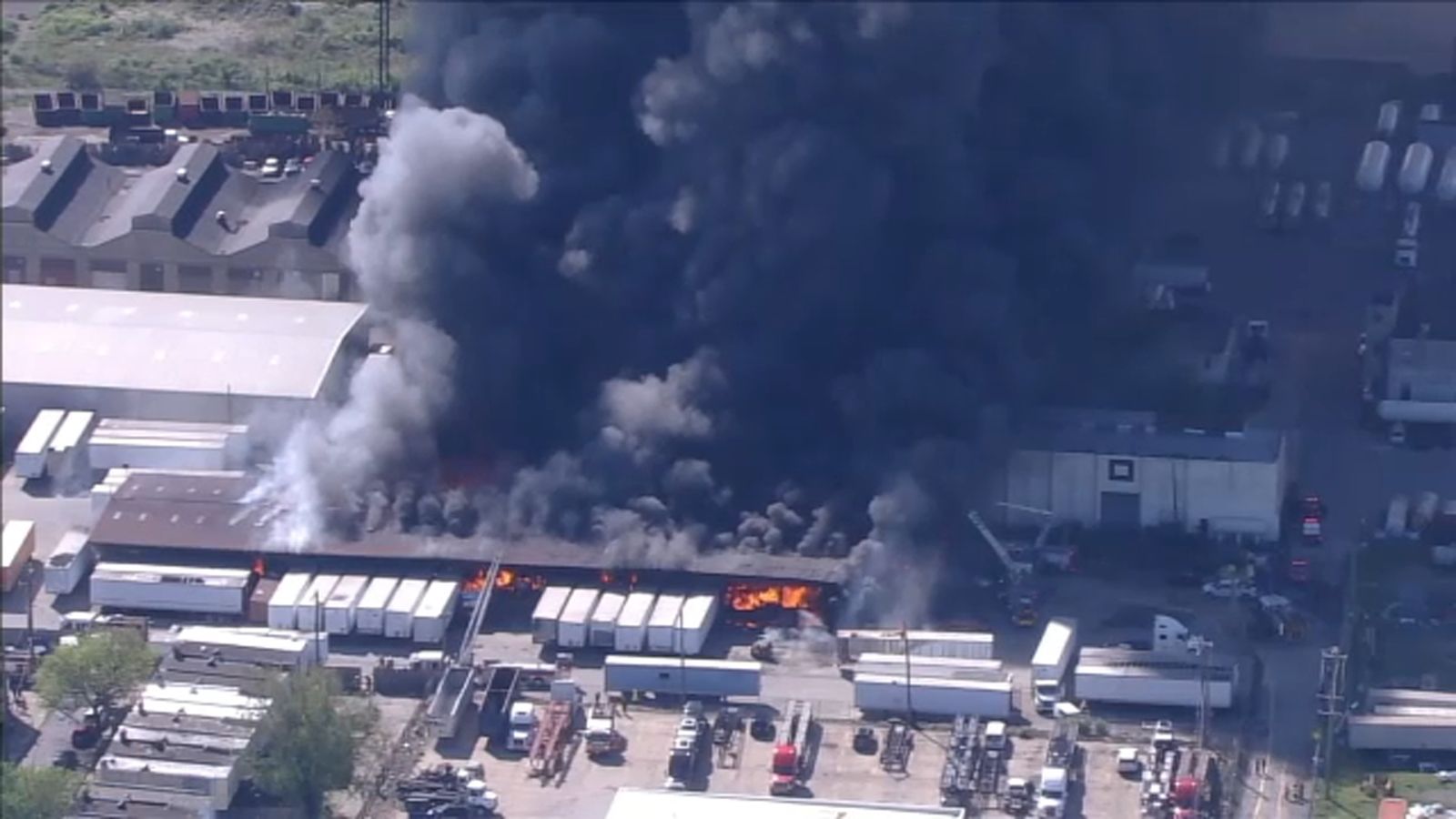Biden Says The Economy’s Doing Great. Lots Of His Own Voters Don’t Believe Him.
Economics Biden Says The Economy’s Doing Great. Lots Of His Own Voters Don’t Believe Him. President Biden’s economic messaging focuses on the middle class, infrastructure investments and job creation. Sam Wolfe / Bloomberg via Getty Images
The economy is doing well. Americans just don’t believe it.
By many metrics — employment, consumer spending and wages — the economic recovery from the fallout of the COVID-19 pandemic was rapid. But Americans have been displeased with President Biden’s handling of the economy since he moved into the job. An Associated Press/NORC Center for Public Affairs Research poll from June found that just 34 percent approved his handling of the economy, barely up from 33 percent from the same pollster in May. A Gallup survey from April found that 64 percent of Americans had little or almost no confidence in Biden on economic issues.
Biden is trying to change that narrative. In a speech in Chicago last month, Biden introduced his economic messaging, one that focuses on the middle class, infrastructure investments and job creation. “Bidenomics is about the future,” he said. “Bidenomics is just another way of saying ‘restore the American Dream because it worked before.’”
But that message may be hard to sell, because arguably those economic shifts haven’t led to dramatic improvements in most Americans’ day-to-day lives.
While the U.S. bounced back quickly from the COVID-19 pandemic and shutdowns, that recovery was also marked by record-high inflation and nearly a year of historic interest rate hikes from the Federal Reserve. That’s left economists forecasting a recession like a dark cloud on the horizon. Some significant wage gains were made, especially for low-income workers, but those were on top of pre-COVID wages that were long considered by many economists and workers to be too low. And wage improvements were smaller for the middle class, which made them easier to ignore in the face of rising inflation. Add all of this together and it’s not hard to understand why even some Democrats are feeling kind of blah about the economy, and why they might not be too excited about Biden’s promises for the future.
Let’s get one thing out of the way — yes, some of the displeasure with Biden’s economic performance is influenced by partisanship. Republicans are the most likely to disapprove of his handling of the economy, and they really disapprove. In the AP poll, only 10 percent ranked him positively on that score. But the surveys are picking up more than just partisan differences. Only 60 percent of Democrats and Democratic-leaners approved of his handling of the economy, and in many cases that approval is lukewarm. In a Navigator Research poll of registered voters, just over a quarter of Democrats strongly approved of Biden’s handling of the economic issues, while 46 percent somewhat approved. In a Morning Consult poll from April, Democrats graded Biden a B on the economy.
That pervasive middling feeling among many Democrats is a problem for a president who’s trying to convince the country that his economic policies can improve their lives. Biden has begun his campaign touting his focus on growing the middle class and creating jobs. But the reality is more complicated than that. While it’s technically true that the economy added millions of jobs under Biden’s watch, that’s at least partly a circumstance of when he took office. The pandemic and resulting economic shutdowns created a deep and sudden recession in the spring of 2020, when millions of Americans lost their jobs in the span of a few weeks, but the recovery began under former President Donald Trump, and Biden came in during the upward swing. And much of the job growth has been in industries disproportionately impacted by the pandemic, which means a lot of the jobs that are being “created” under Biden are making up for the early pandemic losses.
And it’s not clear that the job market will continue to boom — or that people are all that happy with it. In June, unemployment remained low but job growth slowed somewhat, according to the Bureau of Labor Statistics. A slim majority of workers are extremely or very satisfied with their jobs overall, according to a Pew Research Center survey from March, but only 34 percent say they’re satisfied with how much they’re paid. Quit rates have also declined since last spring, meaning fewer workers are confident they could find a new and better job if they left their current one.
Meanwhile, inflation remains high, at just over 4 percent. That’s a marked improvement from a year ago, when inflation reached a peak of 9.1 percent, a 41-year high. The Fed temporarily paused its rate hikes in response, but they might resume again later this summer. Inflation has been one of the highest-ranking voter concerns in polls since before the midterms, but a recent Echelon Insights poll from June offers more specifics about what concerns voters. When asked to rank their concerns from among a more detailed list of choices, 28 percent of Republicans named “cost of living” and 17 percent said “jobs and the economy.” Among Democrats, those figures were 20 and 11 percent, respectively. Cost of living includes everything from grocery store prices to rents, which are finally easing but have been historically high.
Much of what happens with inflation is beyond Biden’s control, and it’s not clear whether or when inflation will return to normal or what the new normal might be. Families are still paying more for goods and services than they were before the pandemic, and they may be locked into high rents or mortgage payments, which means they’ll continue to feel squeezed even as inflation goes down.
And while concern about rapid wage growth drove the Fed’s rate hikes, it’s not clear that higher wages are leading to markedly better living conditions for some Americans. Post-COVID-19 wages have been growing, but mostly from the bottom. Real wage growth for low-wage workers from 2019 to 2022 was 9 percent, according to an analysis from the left-leaning Economic Policy Institute, which means it’s grown faster than inflation. That was partly driven by a high quit rate: The tight labor market meant that employees could leave jobs that weren’t satisfying or well-paying enough for better jobs. That often meant leaving low-paying service sector jobs, like in restaurants, and service sector employers had to raise their wages to lure employees back.
But while that wage growth has been real, wages were starting from a low place. Inflation, meanwhile, has still meant that those workers are paying more for everyday goods and services than they were before, eating into the feeling that they’re making more. “Often, if you are more working class or struggling at the bottom, you are probably spending more than you’re earning, perhaps because you’re in debt, perhaps because you’re working with government assistance,” said Mike Konczal, a director of macroeconomic analysis at the Roosevelt Institute. “And those things are not adjusted for inflation.”
And some of the recent gains for low-wage work may be temporary. Elise Gould, a senior economist at the EPI, said that Biden-era policies were actually responsible for some of that wage growth among the lowest-earning workers. Pandemic-era programs like enhanced unemployment benefits and child tax credits gave low-income workers the cushion they needed to be able to look for new jobs with higher wages, she said. But much of that assistance is gone or is drying up, and the gains could disappear. “There’s nothing that we have right now, in terms of labor standards … that’s going to lock in the wage gains that we have,” she said.
For those in the middle class, wage growth hasn’t been as high. The EPI report found that real wage growth for lower-middle-wage workers was 3.9 percent, 2.4 percent for middle-wage workers and 1.8 percent for those in the upper middle class. The change was driven largely by those who found new jobs, though, which meant that those who stayed in the same jobs likely saw less benefit. And middle-class Americans have seen their wealth take a hit because of higher interest rates, according to a recent Bloomberg analysis.
For younger voters, who are overwhelmingly Democratic, high rents and home prices and general cost-of-living squeeze is about to run into student loan repayment. For the past three years, student debt payments have been paused, but that reprieve will stop at the end of the summer, and a recent Supreme Court ruling guaranteed that the promise of reduced or completely forgiven monthly payments is gone, at least in the near term.
For voters affected by student loans, any economic plan probably has to address relief because it’s integral to those other economic worries. “University and college used to be a guarantee to getting a job,” said Rahhel Haile, a founder of the Minnesota Youth Collective, which advocates for student loan relief and other issues important to younger voters. “And now it’s not as much of a guarantee as it used to be in previous generations.” What Biden does next on student loans, and the costs of college more generally, will determine whether young voters think he has their interests in mind, she said. “I think they need to see more effort … I think he needs to advocate more for young people,” she said.
In the same Echelon poll, respondents were allowed to choose a hypothetical third party that could get their votes. A plurality of Democrats said they wanted a party that would “Put the middle class first, pass universal health insurance, strengthen labor unions, and raise taxes on the wealthy.” Overall, this option was the most popular overall, with support from 31 percent of all respondents and 45 percent from Democrats. That’s the kind of agenda the Biden administration says it has, but he has yet to deliver on most of it. And asking voters to trust in the future is different than pointing to concrete results.
Source: FiveThirtyEight


